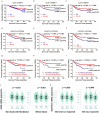Novel Genetic Variants of ALG6 and GALNTL4 of the Glycosylation Pathway Predict Cutaneous Melanoma-Specific Survival
- PMID: 31991610
- PMCID: PMC7072252
- DOI: 10.3390/cancers12020288
Novel Genetic Variants of ALG6 and GALNTL4 of the Glycosylation Pathway Predict Cutaneous Melanoma-Specific Survival
Abstract
Because aberrant glycosylation is known to play a role in the progression of melanoma, we hypothesize that genetic variants of glycosylation pathway genes are associated with the survival of cutaneous melanoma (CM) patients. To test this hypothesis, we used a Cox proportional hazards regression model in a single-locus analysis to evaluate associations between 34,096 genetic variants of 227 glycosylation pathway genes and CM disease-specific survival (CMSS) using genotyping data from two previously published genome-wide association studies. The discovery dataset included 858 CM patients with 95 deaths from The University of Texas MD Anderson Cancer Center, and the replication dataset included 409 CM patients with 48 deaths from Harvard University nurse/physician cohorts. In the multivariable Cox regression analysis, we found that two novel single-nucleotide polymorphisms (SNPs) (ALG6 rs10889417 G>A and GALNTL4 rs12270446 G>C) predicted CMSS, with an adjusted hazards ratios of 0.60 (95% confidence interval = 0.44-0.83 and p = 0.002) and 0.66 (0.52-0.84 and 0.004), respectively. Subsequent expression quantitative trait loci (eQTL) analysis revealed that ALG6 rs10889417 was associated with mRNA expression levels in the cultured skin fibroblasts and whole blood cells and that GALNTL4 rs12270446 was associated with mRNA expression levels in the skin tissues (all p < 0.05). Our findings suggest that, once validated by other large patient cohorts, these two novel SNPs in the glycosylation pathway genes may be useful prognostic biomarkers for CMSS, likely through modulating their gene expression.
Keywords: cutaneous melanoma; expression quantitative trait loci; glycosylation; single-nucleotide polymorphism; survival analysis.
Conflict of interest statement
The authors have no financial and personal relationships with other people or organizations that could inappropriately influence (bias) their work.
Figures


Similar articles
-
Novel genetic variants of PIP5K1C and MVB12B of the endosome-related pathway predict cutaneous melanoma-specific survival.Am J Cancer Res. 2020 Oct 1;10(10):3382-3394. eCollection 2020. Am J Cancer Res. 2020. PMID: 33163277 Free PMC article.
-
Genetic variants in the folate metabolic pathway genes predict cutaneous melanoma-specific survival.Br J Dermatol. 2020 Oct;183(4):719-728. doi: 10.1111/bjd.18878. Epub 2020 Feb 26. Br J Dermatol. 2020. PMID: 31955403 Free PMC article.
-
Association of genetic variants of TMEM135 and PEX5 in the peroxisome pathway with cutaneous melanoma-specific survival.Ann Transl Med. 2021 Mar;9(5):396. doi: 10.21037/atm-20-2117. Ann Transl Med. 2021. PMID: 33842617 Free PMC article.
-
Genetic variants in RORA and DNMT1 associated with cutaneous melanoma survival.Int J Cancer. 2018 Jun 1;142(11):2303-2312. doi: 10.1002/ijc.31243. Epub 2018 Jan 17. Int J Cancer. 2018. PMID: 29313974 Free PMC article.
-
Genetic variants in the metzincin metallopeptidase family genes predict melanoma survival.Mol Carcinog. 2018 Jan;57(1):22-31. doi: 10.1002/mc.22716. Epub 2017 Aug 28. Mol Carcinog. 2018. PMID: 28796414 Free PMC article.
Cited by
-
Integrated Multi-Omics Data Analysis Reveals Associations Between Glycosylation and Stemness in Hepatocellular Carcinoma.Front Oncol. 2022 Jun 23;12:913432. doi: 10.3389/fonc.2022.913432. eCollection 2022. Front Oncol. 2022. PMID: 35814473 Free PMC article.
-
A genome-wide association study of germline variation and melanoma prognosis.Front Oncol. 2023 Jan 19;12:1050741. doi: 10.3389/fonc.2022.1050741. eCollection 2022. Front Oncol. 2023. PMID: 36741706 Free PMC article.
-
Robust Glycogene-Based Prognostic Signature for Proficient Mismatch Repair Colorectal Adenocarcinoma.Front Oncol. 2021 Oct 7;11:727752. doi: 10.3389/fonc.2021.727752. eCollection 2021. Front Oncol. 2021. PMID: 34692502 Free PMC article.
-
Gut Microbial Postbiotics as Potential Therapeutics for Lymphoma: Proteomics Insights of the Synergistic Effects of Nisin and Urolithin B Against Human Lymphoma Cells.Int J Mol Sci. 2025 Jul 16;26(14):6829. doi: 10.3390/ijms26146829. Int J Mol Sci. 2025. PMID: 40725093 Free PMC article.
-
Unique CLR expression patterns on circulating and tumor-infiltrating DC subsets correlated with clinical outcome in melanoma patients.Front Immunol. 2022 Oct 24;13:1040600. doi: 10.3389/fimmu.2022.1040600. eCollection 2022. Front Immunol. 2022. PMID: 36353633 Free PMC article.
References
-
- Cancer Stat Facts: Melanoma of the Skin. [(accessed on 11 January 2020)]; Available online: https://seer.cancer.gov/statfacts/html/melan.html.
Grants and funding
- R01 CA100264, 2P50CA093459 and R01CA133996/National Institutes of Health/National Cancer Institute
- P01 CA087969/CA/NCI NIH HHS/United States
- 81573072/the National Natural Science Foundation of China
- NIH CA014236/Duke Cancer Institute as part of the P30 Cancer Centre Support Grant
- R01 CA49449, P01 CA87969, UM1 CA186107 and UM1 CA167552/National Institutes of Health/National Cancer Institute
LinkOut - more resources
Full Text Sources

